IT Ethics: The Impact of Driverless Trucks on Australia's Society
VerifiedAdded on 2021/05/30
|8
|2237
|115
Essay
AI Summary
This essay delves into the ethical considerations surrounding the introduction of driverless trucks in Australia's transportation sector. It begins by highlighting the potential benefits of automation, such as increased efficiency and reduced operational costs, but primarily focuses on the ethical issues arising from this technological advancement. The essay applies four classical ethical theories – utilitarianism, deontology, virtue theory, and contract theory – to analyze the potential impact on various stakeholders. It examines the potential for job losses among truck drivers and related industries, such as roadside food shops, and the ethical responsibilities of technological advancements. The analysis considers the societal implications of automation, weighing the benefits of technological progress against the potential for economic disruption and social inequality. The conclusion emphasizes the need for proactive measures to mitigate the negative consequences of automation and ensure a just transition for those affected by the changes in the industry. The essay underscores the importance of ethical considerations in the development and implementation of new technologies to ensure a responsible and sustainable future.
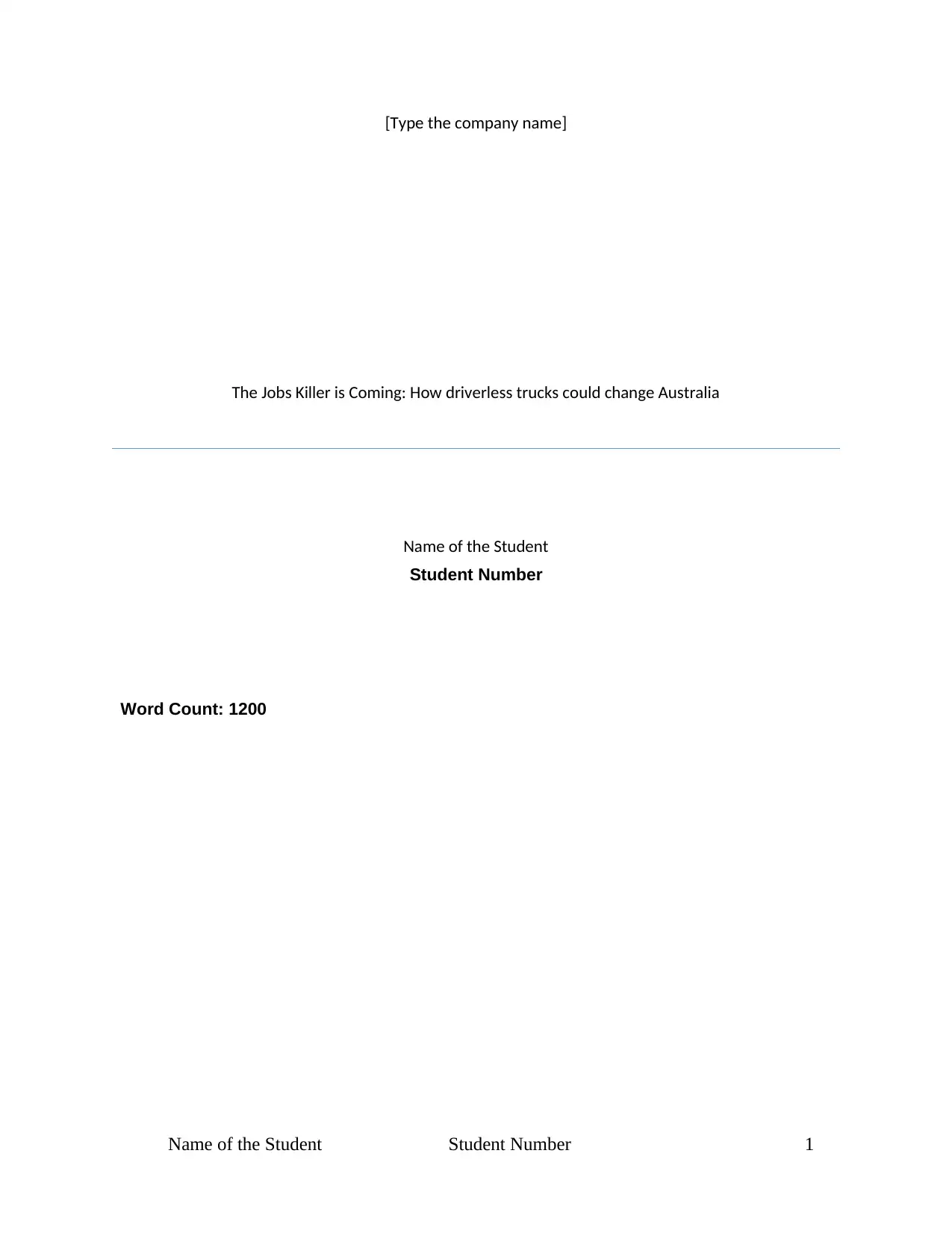
[Type the company name]
The Jobs Killer is Coming: How driverless trucks could change Australia
Name of the Student
Student Number
Word Count: 1200
Name of the Student Student Number 1
The Jobs Killer is Coming: How driverless trucks could change Australia
Name of the Student
Student Number
Word Count: 1200
Name of the Student Student Number 1
Paraphrase This Document
Need a fresh take? Get an instant paraphrase of this document with our AI Paraphraser
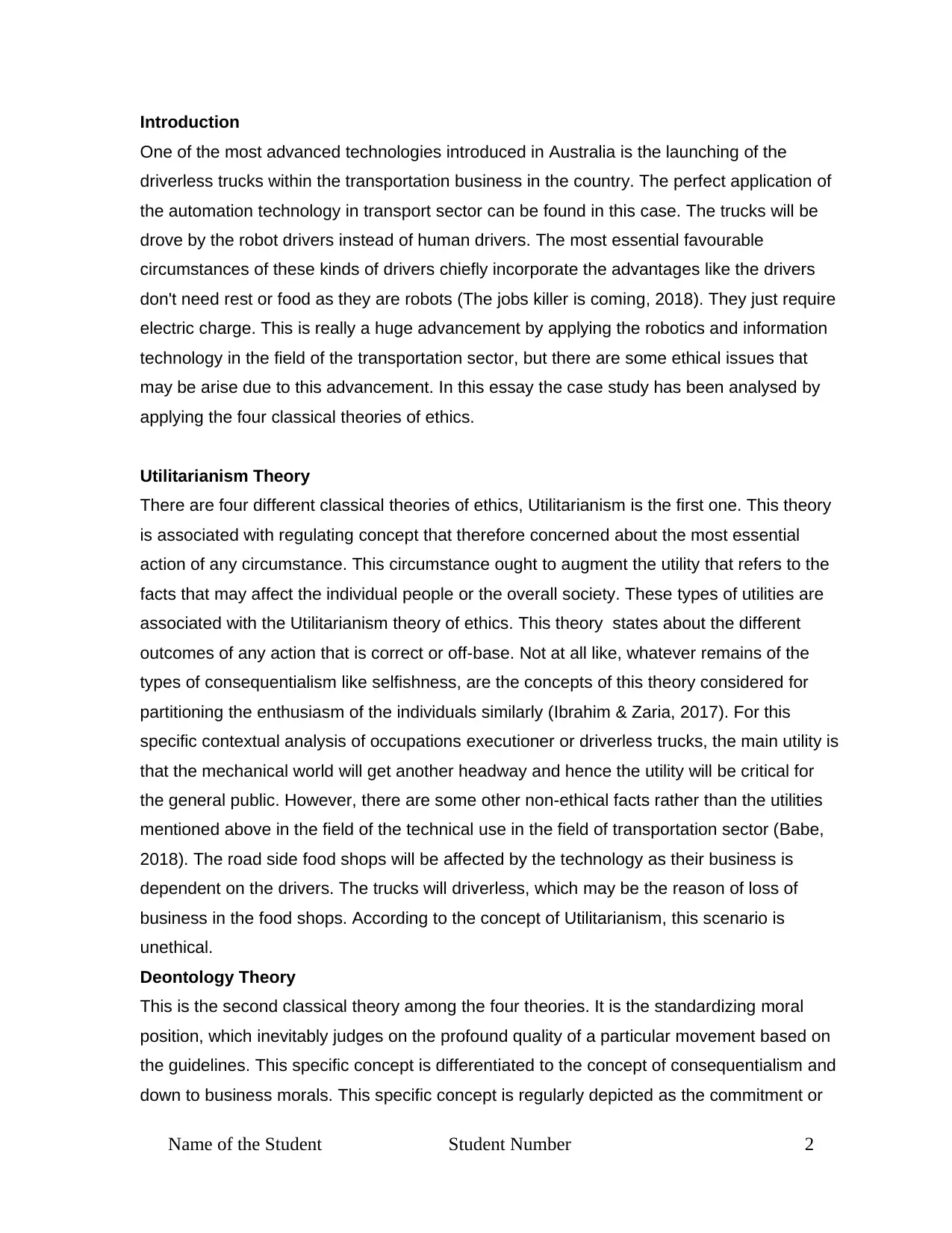
Introduction
One of the most advanced technologies introduced in Australia is the launching of the
driverless trucks within the transportation business in the country. The perfect application of
the automation technology in transport sector can be found in this case. The trucks will be
drove by the robot drivers instead of human drivers. The most essential favourable
circumstances of these kinds of drivers chiefly incorporate the advantages like the drivers
don't need rest or food as they are robots (The jobs killer is coming, 2018). They just require
electric charge. This is really a huge advancement by applying the robotics and information
technology in the field of the transportation sector, but there are some ethical issues that
may be arise due to this advancement. In this essay the case study has been analysed by
applying the four classical theories of ethics.
Utilitarianism Theory
There are four different classical theories of ethics, Utilitarianism is the first one. This theory
is associated with regulating concept that therefore concerned about the most essential
action of any circumstance. This circumstance ought to augment the utility that refers to the
facts that may affect the individual people or the overall society. These types of utilities are
associated with the Utilitarianism theory of ethics. This theory states about the different
outcomes of any action that is correct or off-base. Not at all like, whatever remains of the
types of consequentialism like selfishness, are the concepts of this theory considered for
partitioning the enthusiasm of the individuals similarly (Ibrahim & Zaria, 2017). For this
specific contextual analysis of occupations executioner or driverless trucks, the main utility is
that the mechanical world will get another headway and hence the utility will be critical for
the general public. However, there are some other non-ethical facts rather than the utilities
mentioned above in the field of the technical use in the field of transportation sector (Babe,
2018). The road side food shops will be affected by the technology as their business is
dependent on the drivers. The trucks will driverless, which may be the reason of loss of
business in the food shops. According to the concept of Utilitarianism, this scenario is
unethical.
Deontology Theory
This is the second classical theory among the four theories. It is the standardizing moral
position, which inevitably judges on the profound quality of a particular movement based on
the guidelines. This specific concept is differentiated to the concept of consequentialism and
down to business morals. This specific concept is regularly depicted as the commitment or
Name of the Student Student Number 2
One of the most advanced technologies introduced in Australia is the launching of the
driverless trucks within the transportation business in the country. The perfect application of
the automation technology in transport sector can be found in this case. The trucks will be
drove by the robot drivers instead of human drivers. The most essential favourable
circumstances of these kinds of drivers chiefly incorporate the advantages like the drivers
don't need rest or food as they are robots (The jobs killer is coming, 2018). They just require
electric charge. This is really a huge advancement by applying the robotics and information
technology in the field of the transportation sector, but there are some ethical issues that
may be arise due to this advancement. In this essay the case study has been analysed by
applying the four classical theories of ethics.
Utilitarianism Theory
There are four different classical theories of ethics, Utilitarianism is the first one. This theory
is associated with regulating concept that therefore concerned about the most essential
action of any circumstance. This circumstance ought to augment the utility that refers to the
facts that may affect the individual people or the overall society. These types of utilities are
associated with the Utilitarianism theory of ethics. This theory states about the different
outcomes of any action that is correct or off-base. Not at all like, whatever remains of the
types of consequentialism like selfishness, are the concepts of this theory considered for
partitioning the enthusiasm of the individuals similarly (Ibrahim & Zaria, 2017). For this
specific contextual analysis of occupations executioner or driverless trucks, the main utility is
that the mechanical world will get another headway and hence the utility will be critical for
the general public. However, there are some other non-ethical facts rather than the utilities
mentioned above in the field of the technical use in the field of transportation sector (Babe,
2018). The road side food shops will be affected by the technology as their business is
dependent on the drivers. The trucks will driverless, which may be the reason of loss of
business in the food shops. According to the concept of Utilitarianism, this scenario is
unethical.
Deontology Theory
This is the second classical theory among the four theories. It is the standardizing moral
position, which inevitably judges on the profound quality of a particular movement based on
the guidelines. This specific concept is differentiated to the concept of consequentialism and
down to business morals. This specific concept is regularly depicted as the commitment or
Name of the Student Student Number 2
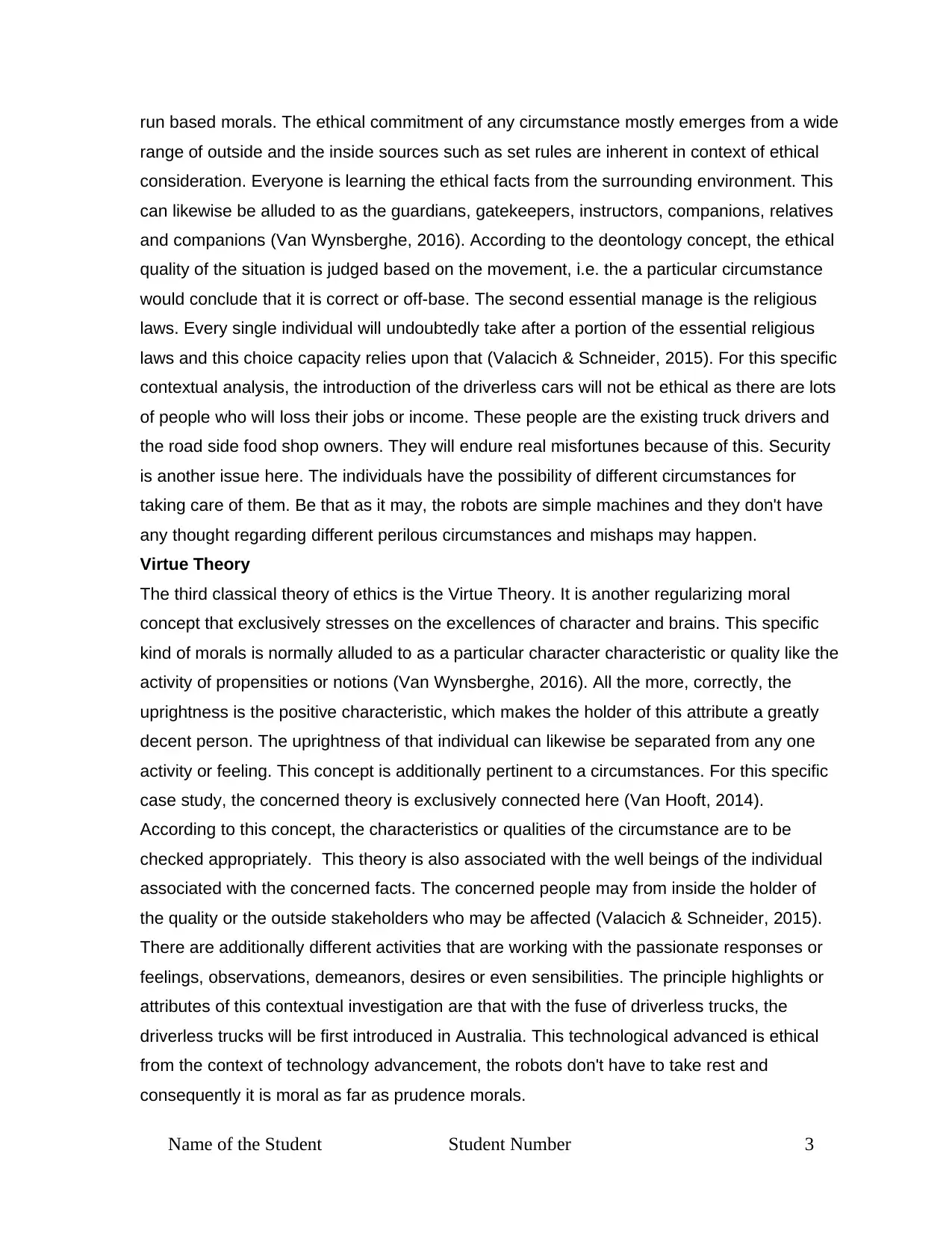
run based morals. The ethical commitment of any circumstance mostly emerges from a wide
range of outside and the inside sources such as set rules are inherent in context of ethical
consideration. Everyone is learning the ethical facts from the surrounding environment. This
can likewise be alluded to as the guardians, gatekeepers, instructors, companions, relatives
and companions (Van Wynsberghe, 2016). According to the deontology concept, the ethical
quality of the situation is judged based on the movement, i.e. the a particular circumstance
would conclude that it is correct or off-base. The second essential manage is the religious
laws. Every single individual will undoubtedly take after a portion of the essential religious
laws and this choice capacity relies upon that (Valacich & Schneider, 2015). For this specific
contextual analysis, the introduction of the driverless cars will not be ethical as there are lots
of people who will loss their jobs or income. These people are the existing truck drivers and
the road side food shop owners. They will endure real misfortunes because of this. Security
is another issue here. The individuals have the possibility of different circumstances for
taking care of them. Be that as it may, the robots are simple machines and they don't have
any thought regarding different perilous circumstances and mishaps may happen.
Virtue Theory
The third classical theory of ethics is the Virtue Theory. It is another regularizing moral
concept that exclusively stresses on the excellences of character and brains. This specific
kind of morals is normally alluded to as a particular character characteristic or quality like the
activity of propensities or notions (Van Wynsberghe, 2016). All the more, correctly, the
uprightness is the positive characteristic, which makes the holder of this attribute a greatly
decent person. The uprightness of that individual can likewise be separated from any one
activity or feeling. This concept is additionally pertinent to a circumstances. For this specific
case study, the concerned theory is exclusively connected here (Van Hooft, 2014).
According to this concept, the characteristics or qualities of the circumstance are to be
checked appropriately. This theory is also associated with the well beings of the individual
associated with the concerned facts. The concerned people may from inside the holder of
the quality or the outside stakeholders who may be affected (Valacich & Schneider, 2015).
There are additionally different activities that are working with the passionate responses or
feelings, observations, demeanors, desires or even sensibilities. The principle highlights or
attributes of this contextual investigation are that with the fuse of driverless trucks, the
driverless trucks will be first introduced in Australia. This technological advanced is ethical
from the context of technology advancement, the robots don't have to take rest and
consequently it is moral as far as prudence morals.
Name of the Student Student Number 3
range of outside and the inside sources such as set rules are inherent in context of ethical
consideration. Everyone is learning the ethical facts from the surrounding environment. This
can likewise be alluded to as the guardians, gatekeepers, instructors, companions, relatives
and companions (Van Wynsberghe, 2016). According to the deontology concept, the ethical
quality of the situation is judged based on the movement, i.e. the a particular circumstance
would conclude that it is correct or off-base. The second essential manage is the religious
laws. Every single individual will undoubtedly take after a portion of the essential religious
laws and this choice capacity relies upon that (Valacich & Schneider, 2015). For this specific
contextual analysis, the introduction of the driverless cars will not be ethical as there are lots
of people who will loss their jobs or income. These people are the existing truck drivers and
the road side food shop owners. They will endure real misfortunes because of this. Security
is another issue here. The individuals have the possibility of different circumstances for
taking care of them. Be that as it may, the robots are simple machines and they don't have
any thought regarding different perilous circumstances and mishaps may happen.
Virtue Theory
The third classical theory of ethics is the Virtue Theory. It is another regularizing moral
concept that exclusively stresses on the excellences of character and brains. This specific
kind of morals is normally alluded to as a particular character characteristic or quality like the
activity of propensities or notions (Van Wynsberghe, 2016). All the more, correctly, the
uprightness is the positive characteristic, which makes the holder of this attribute a greatly
decent person. The uprightness of that individual can likewise be separated from any one
activity or feeling. This concept is additionally pertinent to a circumstances. For this specific
case study, the concerned theory is exclusively connected here (Van Hooft, 2014).
According to this concept, the characteristics or qualities of the circumstance are to be
checked appropriately. This theory is also associated with the well beings of the individual
associated with the concerned facts. The concerned people may from inside the holder of
the quality or the outside stakeholders who may be affected (Valacich & Schneider, 2015).
There are additionally different activities that are working with the passionate responses or
feelings, observations, demeanors, desires or even sensibilities. The principle highlights or
attributes of this contextual investigation are that with the fuse of driverless trucks, the
driverless trucks will be first introduced in Australia. This technological advanced is ethical
from the context of technology advancement, the robots don't have to take rest and
consequently it is moral as far as prudence morals.
Name of the Student Student Number 3
⊘ This is a preview!⊘
Do you want full access?
Subscribe today to unlock all pages.

Trusted by 1+ million students worldwide
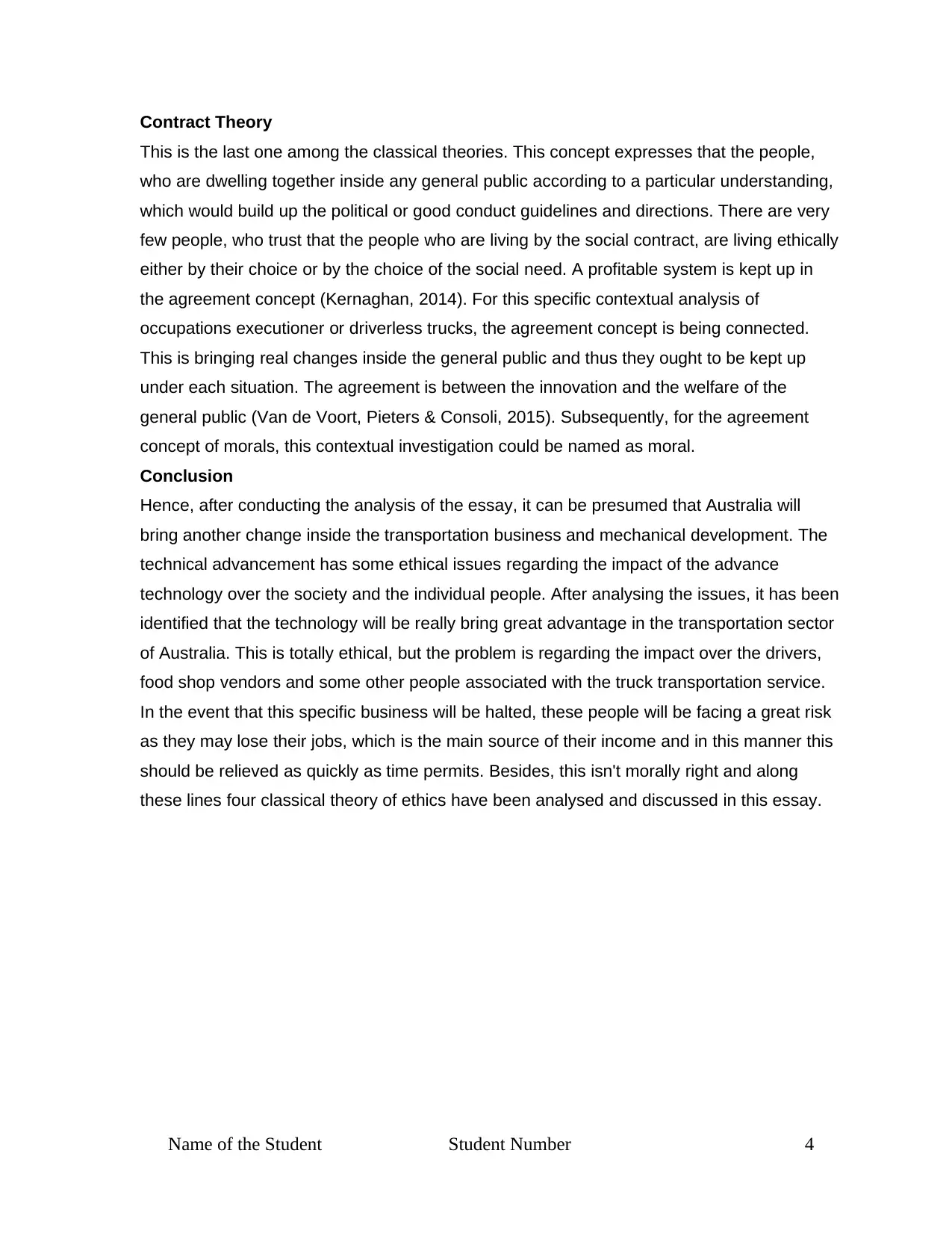
Contract Theory
This is the last one among the classical theories. This concept expresses that the people,
who are dwelling together inside any general public according to a particular understanding,
which would build up the political or good conduct guidelines and directions. There are very
few people, who trust that the people who are living by the social contract, are living ethically
either by their choice or by the choice of the social need. A profitable system is kept up in
the agreement concept (Kernaghan, 2014). For this specific contextual analysis of
occupations executioner or driverless trucks, the agreement concept is being connected.
This is bringing real changes inside the general public and thus they ought to be kept up
under each situation. The agreement is between the innovation and the welfare of the
general public (Van de Voort, Pieters & Consoli, 2015). Subsequently, for the agreement
concept of morals, this contextual investigation could be named as moral.
Conclusion
Hence, after conducting the analysis of the essay, it can be presumed that Australia will
bring another change inside the transportation business and mechanical development. The
technical advancement has some ethical issues regarding the impact of the advance
technology over the society and the individual people. After analysing the issues, it has been
identified that the technology will be really bring great advantage in the transportation sector
of Australia. This is totally ethical, but the problem is regarding the impact over the drivers,
food shop vendors and some other people associated with the truck transportation service.
In the event that this specific business will be halted, these people will be facing a great risk
as they may lose their jobs, which is the main source of their income and in this manner this
should be relieved as quickly as time permits. Besides, this isn't morally right and along
these lines four classical theory of ethics have been analysed and discussed in this essay.
Name of the Student Student Number 4
This is the last one among the classical theories. This concept expresses that the people,
who are dwelling together inside any general public according to a particular understanding,
which would build up the political or good conduct guidelines and directions. There are very
few people, who trust that the people who are living by the social contract, are living ethically
either by their choice or by the choice of the social need. A profitable system is kept up in
the agreement concept (Kernaghan, 2014). For this specific contextual analysis of
occupations executioner or driverless trucks, the agreement concept is being connected.
This is bringing real changes inside the general public and thus they ought to be kept up
under each situation. The agreement is between the innovation and the welfare of the
general public (Van de Voort, Pieters & Consoli, 2015). Subsequently, for the agreement
concept of morals, this contextual investigation could be named as moral.
Conclusion
Hence, after conducting the analysis of the essay, it can be presumed that Australia will
bring another change inside the transportation business and mechanical development. The
technical advancement has some ethical issues regarding the impact of the advance
technology over the society and the individual people. After analysing the issues, it has been
identified that the technology will be really bring great advantage in the transportation sector
of Australia. This is totally ethical, but the problem is regarding the impact over the drivers,
food shop vendors and some other people associated with the truck transportation service.
In the event that this specific business will be halted, these people will be facing a great risk
as they may lose their jobs, which is the main source of their income and in this manner this
should be relieved as quickly as time permits. Besides, this isn't morally right and along
these lines four classical theory of ethics have been analysed and discussed in this essay.
Name of the Student Student Number 4
Paraphrase This Document
Need a fresh take? Get an instant paraphrase of this document with our AI Paraphraser
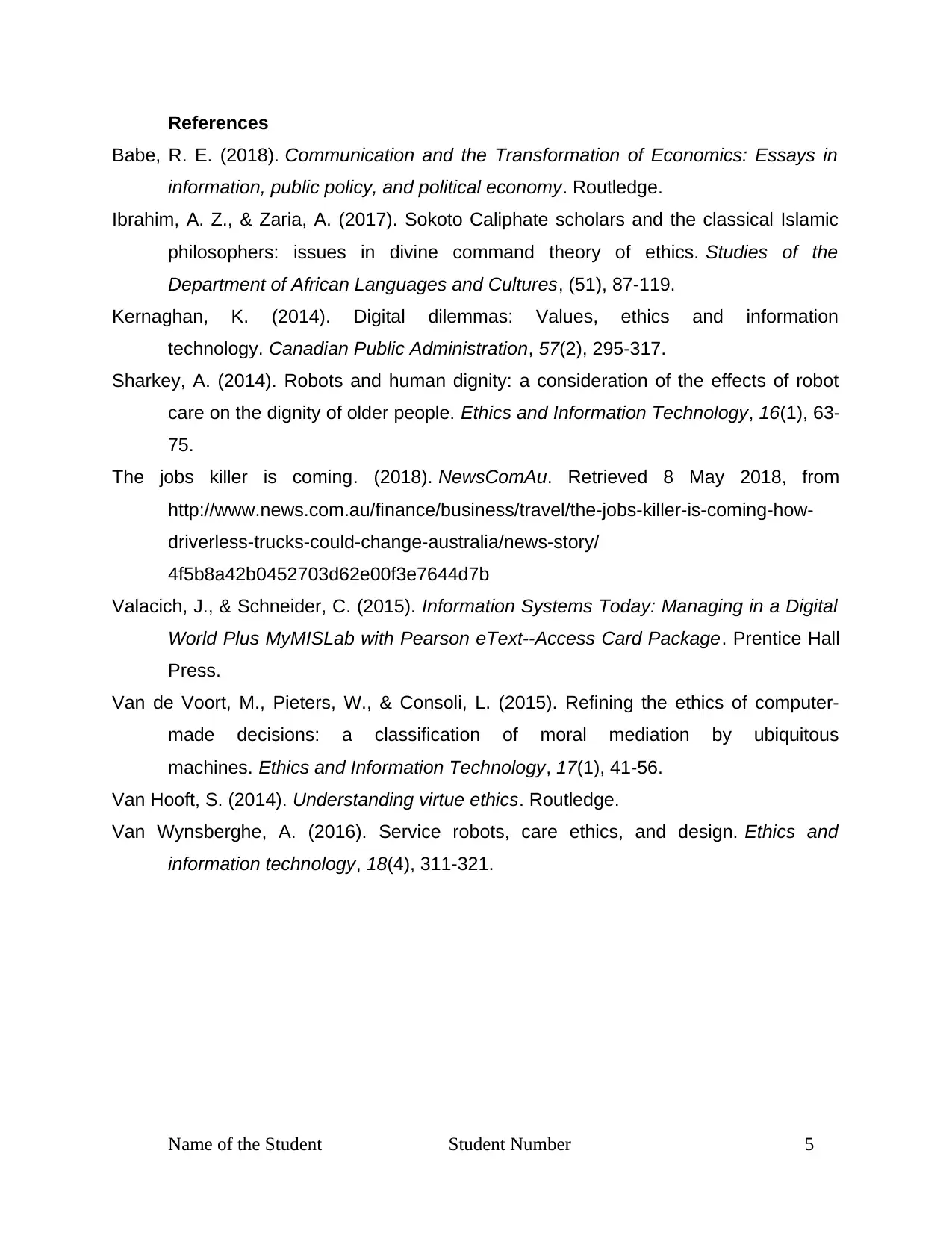
References
Babe, R. E. (2018). Communication and the Transformation of Economics: Essays in
information, public policy, and political economy. Routledge.
Ibrahim, A. Z., & Zaria, A. (2017). Sokoto Caliphate scholars and the classical Islamic
philosophers: issues in divine command theory of ethics. Studies of the
Department of African Languages and Cultures, (51), 87-119.
Kernaghan, K. (2014). Digital dilemmas: Values, ethics and information
technology. Canadian Public Administration, 57(2), 295-317.
Sharkey, A. (2014). Robots and human dignity: a consideration of the effects of robot
care on the dignity of older people. Ethics and Information Technology, 16(1), 63-
75.
The jobs killer is coming. (2018). NewsComAu. Retrieved 8 May 2018, from
http://www.news.com.au/finance/business/travel/the-jobs-killer-is-coming-how-
driverless-trucks-could-change-australia/news-story/
4f5b8a42b0452703d62e00f3e7644d7b
Valacich, J., & Schneider, C. (2015). Information Systems Today: Managing in a Digital
World Plus MyMISLab with Pearson eText--Access Card Package. Prentice Hall
Press.
Van de Voort, M., Pieters, W., & Consoli, L. (2015). Refining the ethics of computer-
made decisions: a classification of moral mediation by ubiquitous
machines. Ethics and Information Technology, 17(1), 41-56.
Van Hooft, S. (2014). Understanding virtue ethics. Routledge.
Van Wynsberghe, A. (2016). Service robots, care ethics, and design. Ethics and
information technology, 18(4), 311-321.
Name of the Student Student Number 5
Babe, R. E. (2018). Communication and the Transformation of Economics: Essays in
information, public policy, and political economy. Routledge.
Ibrahim, A. Z., & Zaria, A. (2017). Sokoto Caliphate scholars and the classical Islamic
philosophers: issues in divine command theory of ethics. Studies of the
Department of African Languages and Cultures, (51), 87-119.
Kernaghan, K. (2014). Digital dilemmas: Values, ethics and information
technology. Canadian Public Administration, 57(2), 295-317.
Sharkey, A. (2014). Robots and human dignity: a consideration of the effects of robot
care on the dignity of older people. Ethics and Information Technology, 16(1), 63-
75.
The jobs killer is coming. (2018). NewsComAu. Retrieved 8 May 2018, from
http://www.news.com.au/finance/business/travel/the-jobs-killer-is-coming-how-
driverless-trucks-could-change-australia/news-story/
4f5b8a42b0452703d62e00f3e7644d7b
Valacich, J., & Schneider, C. (2015). Information Systems Today: Managing in a Digital
World Plus MyMISLab with Pearson eText--Access Card Package. Prentice Hall
Press.
Van de Voort, M., Pieters, W., & Consoli, L. (2015). Refining the ethics of computer-
made decisions: a classification of moral mediation by ubiquitous
machines. Ethics and Information Technology, 17(1), 41-56.
Van Hooft, S. (2014). Understanding virtue ethics. Routledge.
Van Wynsberghe, A. (2016). Service robots, care ethics, and design. Ethics and
information technology, 18(4), 311-321.
Name of the Student Student Number 5
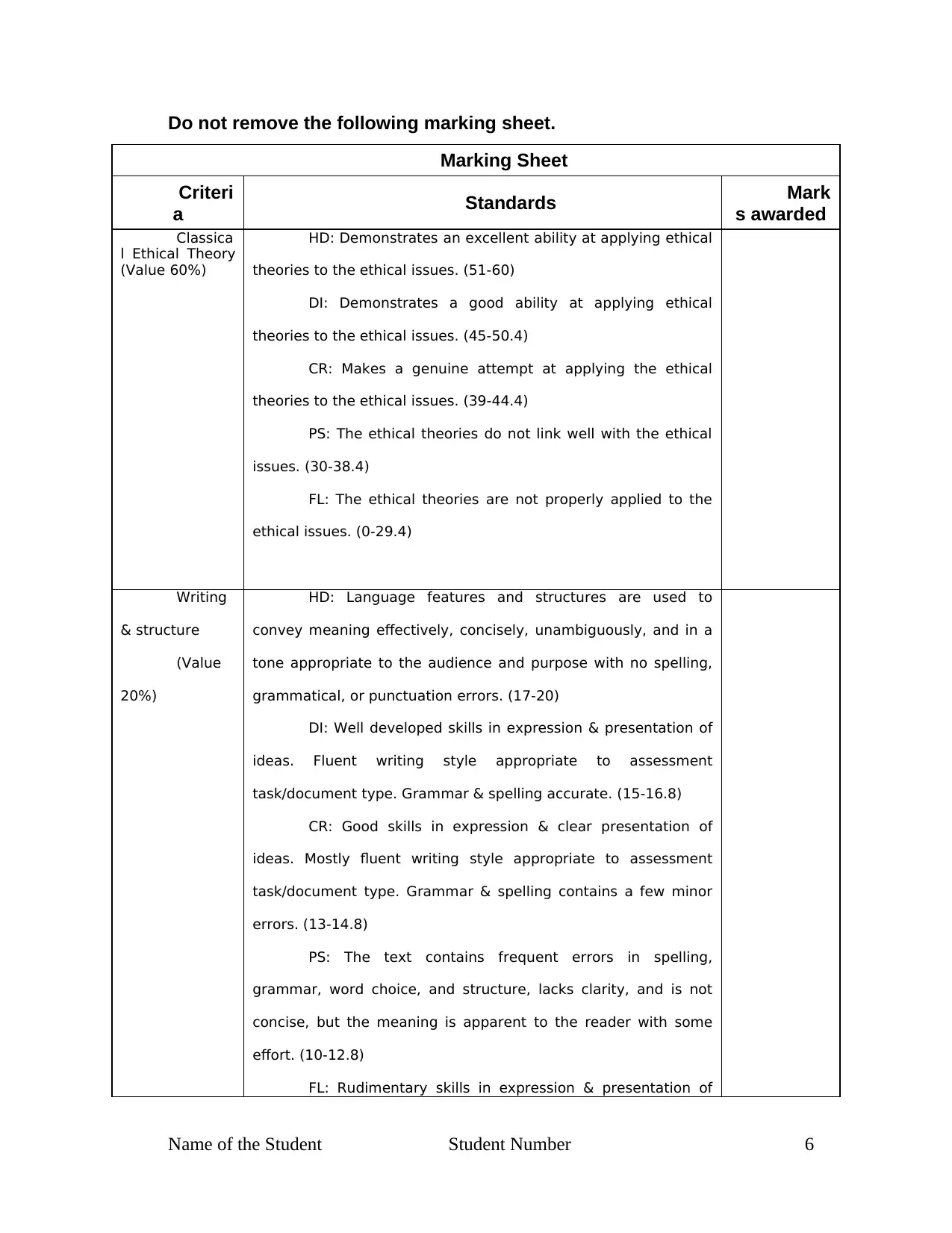
Do not remove the following marking sheet.
Marking Sheet
Criteri
a Standards Mark
s awarded
Classica
l Ethical Theory
(Value 60%)
HD: Demonstrates an excellent ability at applying ethical
theories to the ethical issues. (51-60)
DI: Demonstrates a good ability at applying ethical
theories to the ethical issues. (45-50.4)
CR: Makes a genuine attempt at applying the ethical
theories to the ethical issues. (39-44.4)
PS: The ethical theories do not link well with the ethical
issues. (30-38.4)
FL: The ethical theories are not properly applied to the
ethical issues. (0-29.4)
Writing
& structure
(Value
20%)
HD: Language features and structures are used to
convey meaning effectively, concisely, unambiguously, and in a
tone appropriate to the audience and purpose with no spelling,
grammatical, or punctuation errors. (17-20)
DI: Well developed skills in expression & presentation of
ideas. Fluent writing style appropriate to assessment
task/document type. Grammar & spelling accurate. (15-16.8)
CR: Good skills in expression & clear presentation of
ideas. Mostly fluent writing style appropriate to assessment
task/document type. Grammar & spelling contains a few minor
errors. (13-14.8)
PS: The text contains frequent errors in spelling,
grammar, word choice, and structure, lacks clarity, and is not
concise, but the meaning is apparent to the reader with some
effort. (10-12.8)
FL: Rudimentary skills in expression & presentation of
Name of the Student Student Number 6
Marking Sheet
Criteri
a Standards Mark
s awarded
Classica
l Ethical Theory
(Value 60%)
HD: Demonstrates an excellent ability at applying ethical
theories to the ethical issues. (51-60)
DI: Demonstrates a good ability at applying ethical
theories to the ethical issues. (45-50.4)
CR: Makes a genuine attempt at applying the ethical
theories to the ethical issues. (39-44.4)
PS: The ethical theories do not link well with the ethical
issues. (30-38.4)
FL: The ethical theories are not properly applied to the
ethical issues. (0-29.4)
Writing
& structure
(Value
20%)
HD: Language features and structures are used to
convey meaning effectively, concisely, unambiguously, and in a
tone appropriate to the audience and purpose with no spelling,
grammatical, or punctuation errors. (17-20)
DI: Well developed skills in expression & presentation of
ideas. Fluent writing style appropriate to assessment
task/document type. Grammar & spelling accurate. (15-16.8)
CR: Good skills in expression & clear presentation of
ideas. Mostly fluent writing style appropriate to assessment
task/document type. Grammar & spelling contains a few minor
errors. (13-14.8)
PS: The text contains frequent errors in spelling,
grammar, word choice, and structure, lacks clarity, and is not
concise, but the meaning is apparent to the reader with some
effort. (10-12.8)
FL: Rudimentary skills in expression & presentation of
Name of the Student Student Number 6
⊘ This is a preview!⊘
Do you want full access?
Subscribe today to unlock all pages.

Trusted by 1+ million students worldwide
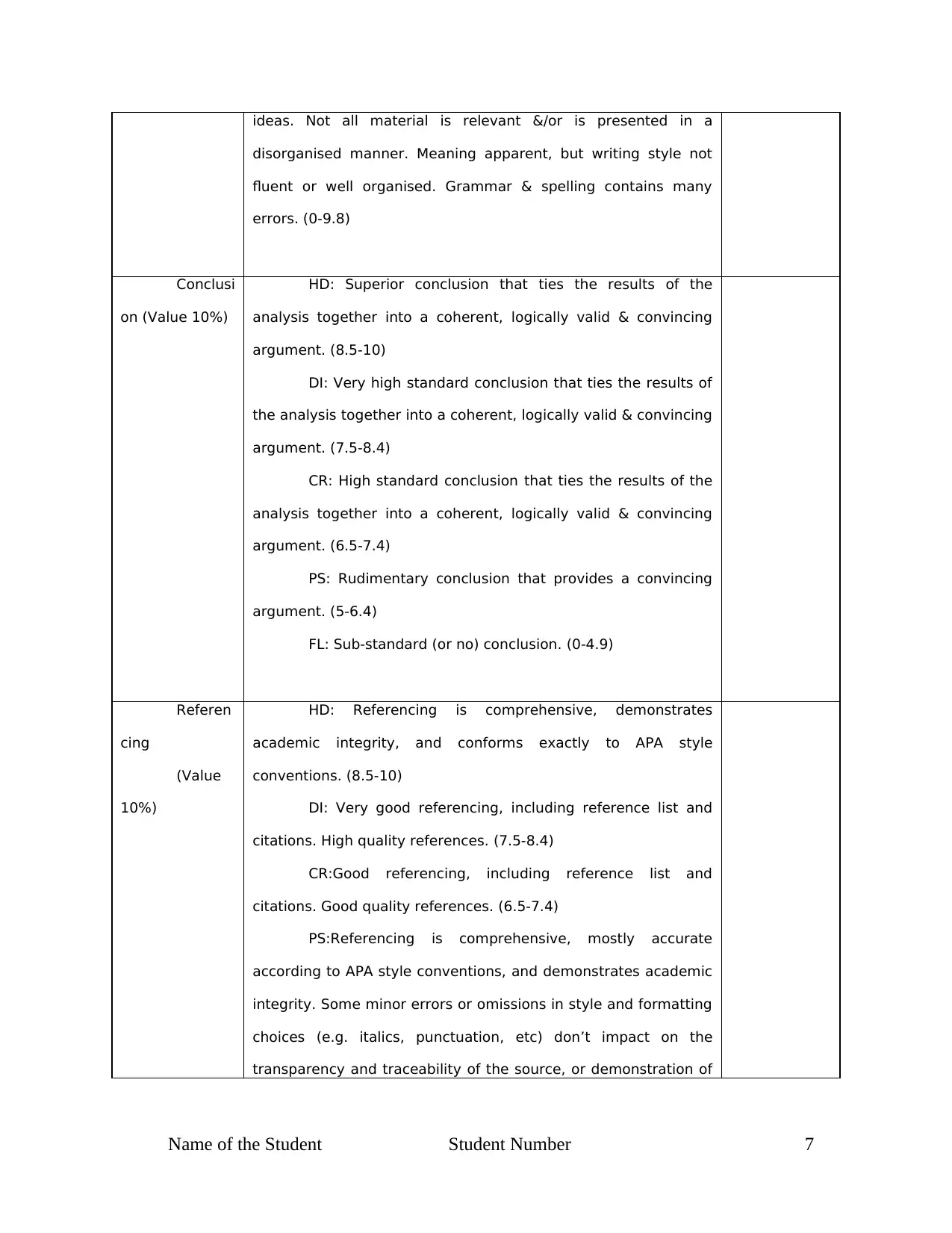
ideas. Not all material is relevant &/or is presented in a
disorganised manner. Meaning apparent, but writing style not
fluent or well organised. Grammar & spelling contains many
errors. (0-9.8)
Conclusi
on (Value 10%)
HD: Superior conclusion that ties the results of the
analysis together into a coherent, logically valid & convincing
argument. (8.5-10)
DI: Very high standard conclusion that ties the results of
the analysis together into a coherent, logically valid & convincing
argument. (7.5-8.4)
CR: High standard conclusion that ties the results of the
analysis together into a coherent, logically valid & convincing
argument. (6.5-7.4)
PS: Rudimentary conclusion that provides a convincing
argument. (5-6.4)
FL: Sub-standard (or no) conclusion. (0-4.9)
Referen
cing
(Value
10%)
HD: Referencing is comprehensive, demonstrates
academic integrity, and conforms exactly to APA style
conventions. (8.5-10)
DI: Very good referencing, including reference list and
citations. High quality references. (7.5-8.4)
CR:Good referencing, including reference list and
citations. Good quality references. (6.5-7.4)
PS:Referencing is comprehensive, mostly accurate
according to APA style conventions, and demonstrates academic
integrity. Some minor errors or omissions in style and formatting
choices (e.g. italics, punctuation, etc) don’t impact on the
transparency and traceability of the source, or demonstration of
Name of the Student Student Number 7
disorganised manner. Meaning apparent, but writing style not
fluent or well organised. Grammar & spelling contains many
errors. (0-9.8)
Conclusi
on (Value 10%)
HD: Superior conclusion that ties the results of the
analysis together into a coherent, logically valid & convincing
argument. (8.5-10)
DI: Very high standard conclusion that ties the results of
the analysis together into a coherent, logically valid & convincing
argument. (7.5-8.4)
CR: High standard conclusion that ties the results of the
analysis together into a coherent, logically valid & convincing
argument. (6.5-7.4)
PS: Rudimentary conclusion that provides a convincing
argument. (5-6.4)
FL: Sub-standard (or no) conclusion. (0-4.9)
Referen
cing
(Value
10%)
HD: Referencing is comprehensive, demonstrates
academic integrity, and conforms exactly to APA style
conventions. (8.5-10)
DI: Very good referencing, including reference list and
citations. High quality references. (7.5-8.4)
CR:Good referencing, including reference list and
citations. Good quality references. (6.5-7.4)
PS:Referencing is comprehensive, mostly accurate
according to APA style conventions, and demonstrates academic
integrity. Some minor errors or omissions in style and formatting
choices (e.g. italics, punctuation, etc) don’t impact on the
transparency and traceability of the source, or demonstration of
Name of the Student Student Number 7
Paraphrase This Document
Need a fresh take? Get an instant paraphrase of this document with our AI Paraphraser
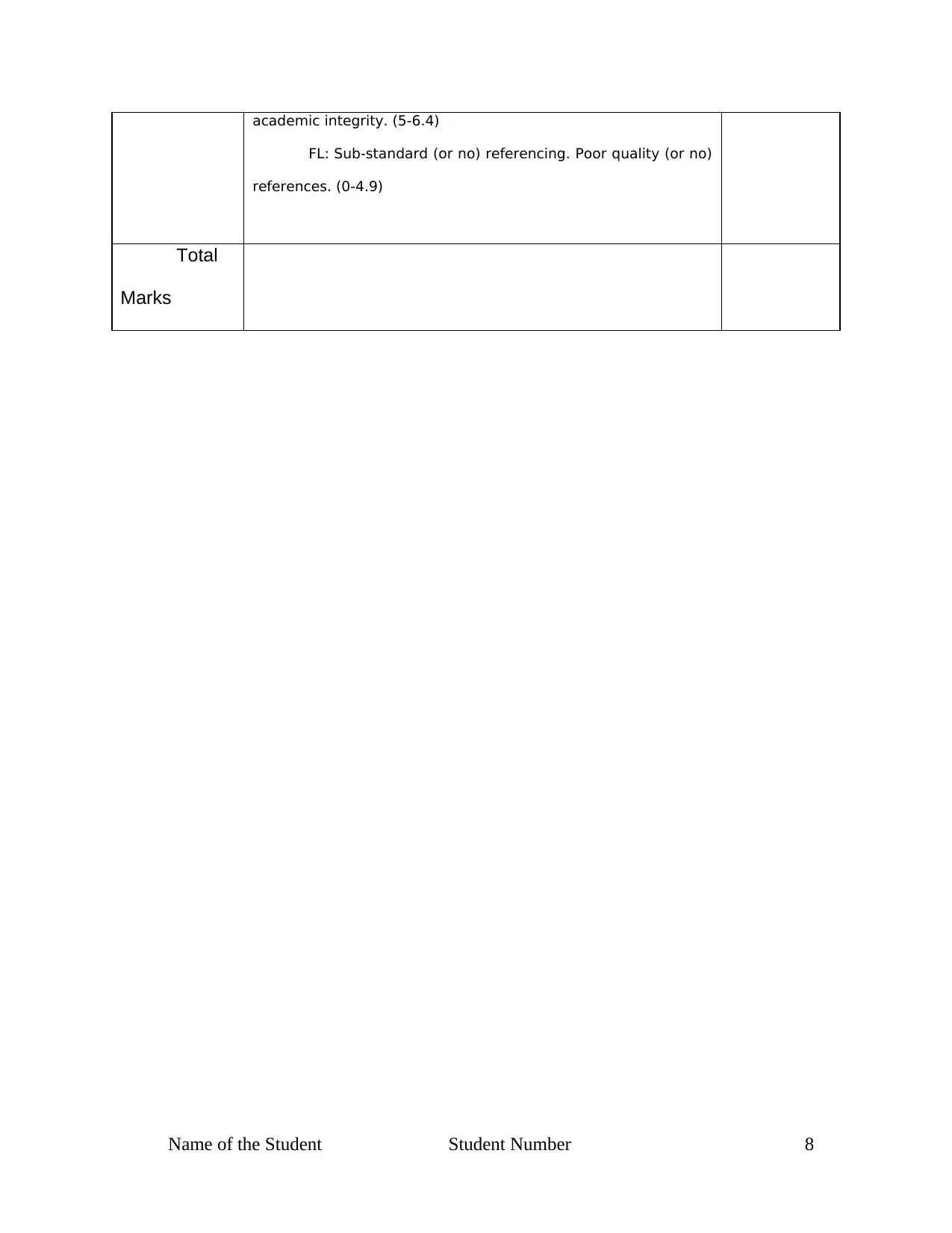
academic integrity. (5-6.4)
FL: Sub-standard (or no) referencing. Poor quality (or no)
references. (0-4.9)
Total
Marks
Name of the Student Student Number 8
FL: Sub-standard (or no) referencing. Poor quality (or no)
references. (0-4.9)
Total
Marks
Name of the Student Student Number 8
1 out of 8
Related Documents
Your All-in-One AI-Powered Toolkit for Academic Success.
+13062052269
info@desklib.com
Available 24*7 on WhatsApp / Email
![[object Object]](/_next/static/media/star-bottom.7253800d.svg)
Unlock your academic potential
Copyright © 2020–2025 A2Z Services. All Rights Reserved. Developed and managed by ZUCOL.





